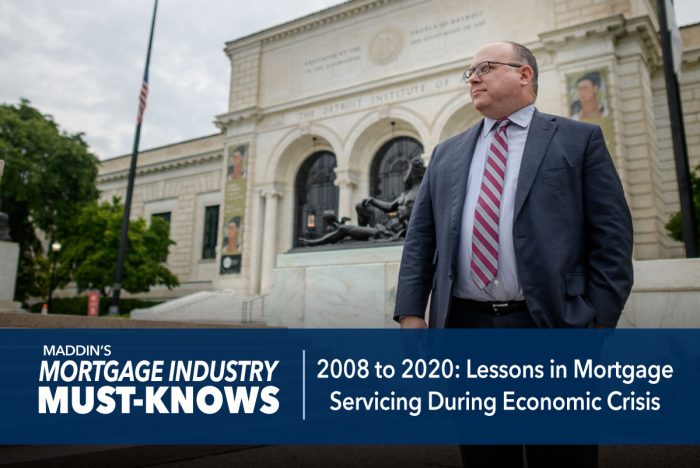
2008 to 2020: Lessons in Mortgage Servicing During Economic Crisis
COVID-19 has caused sudden and significant disruption in our lives and in commerce. Across the country, state and local governments have shut down non-essential functions, ordered businesses to close, and restricted non-essential travel to slow the spread of the virus. The result has been a sudden increase in unemployment, market turmoil, and the halting of commerce. Our lending and servicing clients face an immediate future which includes many borrowers and renters unable to pay their mortgage loans, increased demands for loss mitigation and forbearance, and a reduced internal work force.
Although the cause of the current crisis is different, the 2008 financial crisis provides a framework – at least with regard to aspects of default servicing – for the path forward. Like 2008, the current economic crisis will lead to an increase in the volume of distressed borrowers and payment defaults, which will in turn place strain on mortgage servicers and their default servicing departments – particularly where such departments have atrophied after a lengthy economic expansion.
Guidance from GSEs, investors, and State and Federal governments seeks to provide some relief for consumers adversely affected by the pandemic. But lenders and servicers must quickly implement that guidance with appropriate care. As in 2008, the federal government is standing up significant liquidity facilities and other measures to assist the industry, particularly as a sharp rise in forbearance requests is likely to place a severe financial and compliance strain on servicers, but that relief may come with requirements to offer certain consumer relief.
Below is a brief snapshot of some of the current relief measures that have been implemented, as well as a discussion of some of the lessons learned during the last financial crisis in 2008.
Current Measures
State and local governments have attempted to mitigate consumer financial distress by issuing moratoriums on evictions. For example, Los Angeles, New York City, San Jose, and Miami-Dade County have issued orders halting evictions, with at least one jurisdiction expressly providing that the new order could be pled as a defense in any eviction action.
HUD and FHFA previously announced moratoriums on foreclosures and evictions for single family homeowners for the next 60 days, with the State of New York issuing guidance calling for a 90-day moratorium. In an effort to provide rental relief, the FHFA recently announced that the GSEs will provide mortgage forbearance to owners of multifamily properties on the condition that those owners suspend all evictions during that time period.
Fannie and Freddie have issued guidance directing servicers to pay close attention to forbearance and loss mitigation options for borrowers affected by COVID-19, including payment forbearance for up to 12 months due to resulting hardship. In addition, Fannie and Freddie have relaxed certain underwriting guidelines to help facilitate loan closings. The new guidance reduces the need for appraisers to inspect a home’s interior and the need to obtain verbal employment verifications.
Additional measures intended to assist struggling consumers seeking a forbearance or other loss mitigation include:
- Providing payment relief up to 12 months
- Waiving penalties and late fees
- Suspending derogatory credit reporting
- Providing borrowers who are placed on a forbearance plan the opportunity to apply for additional loss mitigation options, including payment relief
All of these measures present challenges to lenders and servicers in their efforts to manage what is expected to be a significant surge in distressed borrowers.
Lessons from 2008
In the wake of the 2008 financial crisis, many servicers struggled to properly manage default servicing. There was confusion regarding implementation of loss mitigation options, interest calculations, appropriate loan amortization and escrow calculations, proper credit reporting, and improper foreclosures. Although Dodd-Frank and the implementing regulations provide some clarity that was lacking in 2008 and 2009, lenders and servicers must still be prepared to implement potentially varied loss mitigation and forbearance options in the midst of a national crisis.
It will be essential, for example, to ensure that all borrowers are provided the appropriate loss mitigation and forbearance opportunities. Given the lack of documentation requirements (borrowers are not required to provide significant documentation of their COVID-19 hardships), the potential for fraud is significant. In addition, potential variations in the guidelines ultimately issued by the GSEs and agencies, as well as private investor forbearance options, can create confusion when administering loss mitigation.
Controls must be implemented to avoid late fees and penalties being posted to borrower accounts, and this will require gaining clarity as to exactly which fees constitute penalties. In addition, steps must be taken to ensure that no adverse credit reporting is submitted and if a reporting failure occurs, care must be taken to make certain it is corrected upon receipt of a dispute. Similar controls must be implemented to avoid foreclosures or evictions during the moratoriums and any forbearance periods.
We can expect housing and consumer advocates to argue that the relief measures announced by the GSEs, the agencies, and non-public institutions is mandatory, and that any failure to award such relief constitutes a violation of the loss mitigation rules set forth in Reg X. It will, therefore, be essential to document consideration of the loss mitigation process for each borrower to avoid such claims.
Servicing transfers will require that thorough documentation is maintained regarding any current forbearance or other loss mitigation awards for transferred loans. Likewise, the data accompanying each transferred loan will need to ensure that protections regarding credit reporting, loss mitigation eligibility, waiver of fees and penalties follow the loan to the new servicer.
In short, lenders and servicers are going to be asked to implement new and potentially varied consumer relief measures at the same time they are undergoing significant institutional stress as a result of the virus. Drawing on the lessons learned during the last financial crisis can help us identify and monitor those areas ripe for potential errors and reduce potential borrower claims.

Brian A. Nettleingham
Shareholder in Maddin Hauser’s Financial Services and Real Property Litigation, Complex Litigation and Risk Advisory, and Banking Groups.
Phone: (248) 359-7503
Fax: (248) 359-7553
BNettleingham@maddinhauser.com
































